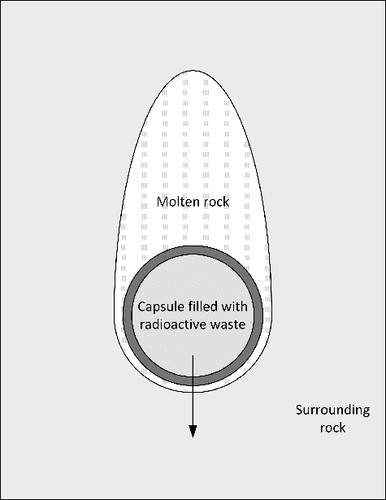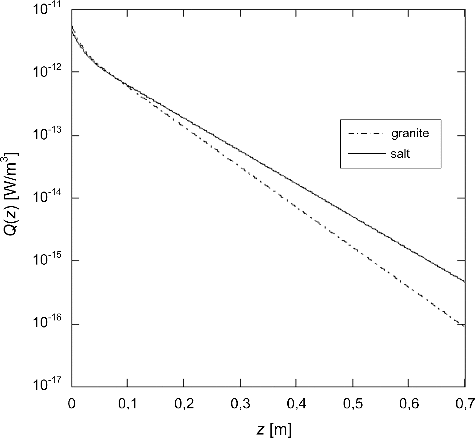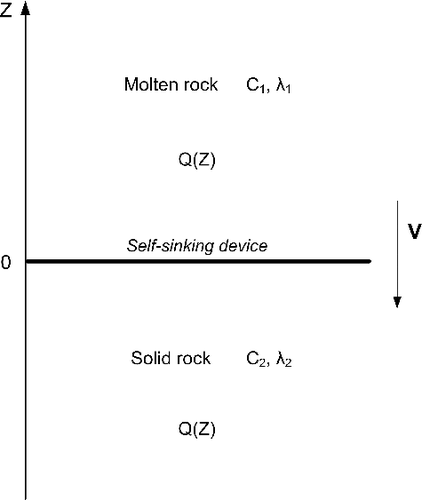 ?Mathematical formulae have been encoded as MathML and are displayed in this HTML version using MathJax in order to improve their display. Uncheck the box to turn MathJax off. This feature requires Javascript. Click on a formula to zoom.
?Mathematical formulae have been encoded as MathML and are displayed in this HTML version using MathJax in order to improve their display. Uncheck the box to turn MathJax off. This feature requires Javascript. Click on a formula to zoom.ABSTRACT
The method of self-burial of radioactive waste in geological formations using direct heating of rocks by radiation is proposed in this paper. In the currently known studies, thermal conductivity is considered as a main heat transfer mechanism. Application of high penetrating gamma radiation for direct melting of surrounding rocks will reduce the energy absorption inside the sinking device and will lower maximum temperature and temperature gradients in the elements of the device. In this paper, conditions of realization of the direct heating by radiation mechanism are presented and requirements to heat-generating radionuclides have been derived. Assessments of the spatial distribution of energy release in the surrounding rocks for the point and plane sources with the radionuclide 60Co have been performed. Based on these data, the temperature distributions in the surrounding rocks and the expression for determining the descent velocity as a function of 60Co surface activity in the sinking device have been obtained. Estimations of energy absorption fraction inside the spherical heat-generating elements filled with 60Co and surface activity of 60Co, necessary to achieve velocity of about 1 km per year, have been made. The results are given for granite and salt rocks.
1. Introduction
A serious problem for radioactive waste (RW) management in nuclear power engineering is the safe disposal of long-lived transuranium elements, the half-life of which reaches hundreds or more years. At present, the generation rate of transuranium elements to be buried is about 50 kg/GW·yr.
Considering the further increase in the number of nuclear power plants in the world, amount of RW will increase, which makes the problem of their withdrawal from the biosphere relevant in the future.
For the final disposal of waste containing transuranium elements, it is required to use deep disposal in geological formations [Citation1]. Work on the development of such storage facilities is carried out in the world; there are known projects of Sweden (Oskarhamn, Aspo laboratory), Finland (Olkiluoto, ONKALO laboratory), USA (Nevada, Yucca Mountain), and others [Citation2]. In Russia, a project for disposal of RW in the Nizhnekansk granitoid massif is being developed, and an underground research laboratory is planned in the near future. However, justifying the safety of such storage facilities for many years to come is a very difficult task and involves considerable uncertainties in the modeling of processes potentially leading to release of radionuclides into the environment.
Among other options for solving the problem of RW isolation from the biosphere are: removal into space orbit beyond the earth, transmutation in fast neutron reactors, burning of radioactive isotopes with fast neutrons in special installations and self-burial in geological formations at great depths using heat generated by radionuclides contained in RW.
The method of self-burial, in which the energy released during radioactive decay is used to melt the surrounding rocks, is actively discussed in scientific works ([Citation3–19], etc.). In addition, there are a number of patents (for example, [Citation20–22]) on radioisotope devices and sinking methods based on the self-burial scheme. The method seems promising as it potentially allows disposal of RW at the depths (tens and hundreds of kilometers) inaccessible by other known methods. The method provides a multi-layered geological barrier that separates RW from the biosphere. Due to the possibility of deep sinking into the earth's interior layers, the method is also of interest from the point of view of conducting geological studies [Citation11,Citation13].
In this paper, we consider improved method of RW self-burial based on the energy transfer mechanism of direct heating of rocks by radiation. The published works and patents present the devices for sinking in rocks, where the thermal conductivity is the main mechanism for transfer of heat to surrounding rock. A disadvantage of this mechanism is the absorption of a significant fraction of released energy inside the device. The heating of rocks by radiation with high penetrating radiation, when the most part (>80%) of the energy released by the radionuclides contained in the device will be absorbed outside the device, will allow reducing the temperature loads on the elements of the device and thereby improving reliability.
The article briefly characterizes the known methods and radioisotope devices for sinking in molten rocks. The principal features of direct heating by radiation mechanism, the conditions for its implementation, and the choice of radionuclides that provide the necessary energy release rate are considered. The estimations of certain parameters of devices sinking by proposed energy transfer mechanism are made. Calculations of energy release rate in surrounding materials such as granite and salt for gamma radiation of 60Co radionuclide are carried out. Using these data, temperature distributions and descent velocity dependence on the average surface activity of radionuclides for device sinking in granite and salt have been obtained on the basis of the system of heat conduction equations in a one-dimensional quasi-stationary approximation. Evaluations of energy self-absorption fraction in the sinking device are also presented.
2. Sinking by melting of surrounding rocks
A method of sinking of spherical or cylindrical capsules melting the rocks due to heat release as a result of radioactive decay of radionuclides contained in RW is described in [Citation3–19]. Sinking deep into the rock occurs under gravity. The resulting melt of the rock is cooled behind the capsule, providing isolation barrier from the environment. A simplified diagram of the sinking is shown in . For wastes with different characteristics, the authors of the papers provide estimates of the sinking parameters, such as the threshold value of capsule heat-generation rate, the descent velocity, and the burial depth in the surrounding rocks: granite, basalt, etc. The typical sizes of the capsules in question are from 0.1 to 1 m. Energy from the capsule to the rock is transferred by thermal conductivity, which leads to high levels of maximum temperatures and temperature gradients in the elements of the structure. So the temperature in the center of the capsule can reach 2000–3000 °С [Citation9].
To avoid high temperatures, the patents [Citation21,Citation22] propose design of the device in the form of a flat heat-generating element, or a flat spatial heat-generating structure with mechanically bound heat-generating elements of small size (about several centimeters) (see ). It is assumed that RW to be disposed and the radionuclides providing heat necessary for sinking are located separately. The heat-generating elements are filled with radionuclides with a high energy release rate (for example, 137Cs, 90Sr, 60Co, 241Am). RW including long-lived fission products and isotopes of transuranium elements are placed in separate containers fixed to the device. If the device is used for research purposes, the corresponding equipment may be placed in separate containers fixed to the device from the side opposite to movement.
Figure 2. Sinking device in the form of spatial structure: (1) spherical heat-generating elements; (2) connecting elements.
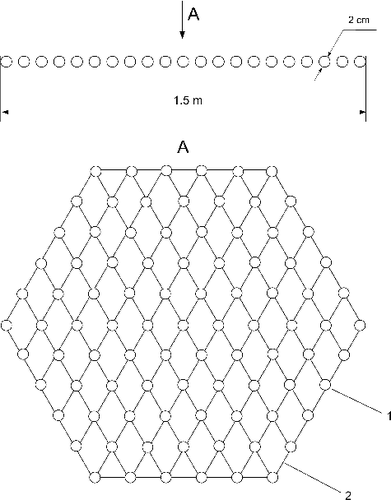
The authors of [Citation11,Citation14–17] pay attention to investigation of the earth's inner layers using radioisotope sinking devices. In particular, it is mentioned that detection and analysis of acoustic signals during melting and crystallization of rocks can provide information on deep layers of the earth that is not available through direct sampling, as well as supplement the data of other remote geophysical monitoring methods.
At present, this method of sinking and disposal of RW is at the stage of research, which is mainly of a theoretical nature. At the same time, there are a number of problems associated with high temperatures inside the capsule, as well as corrosion resistance of structural materials in rock melts. Nevertheless, the method remains attractive for further study due to the geological barrier created by the upper layers of rock and is potentially safer in comparison with the developed deep disposal sites.
3. Direct heating of surrounding rocks by radiation
The authors of this article suggest using a mechanism for direct heating of rocks by radiation to transfer energy to surrounding rock. The sinking method based on this mechanism is disclosed in the patent [Citation22]. Direct heating by radiation means the transfer of radiation with its subsequent absorption in the material of surrounding rock. This mechanism implies the absorption of most of the radiation and energy outside the device, which will help reduce the temperature load on the elements of the device and increase its reliability. This condition can be ensured by a shape of the device close to flat and using radionuclides having high specific energy release due to radioactive decay and emitting high penetrating radiation. Radionuclides with such characteristics include gamma-emitters with high energy of radiation and yield of photons. In addition, the half-life of radionuclides should ensure high specific activity, and consequently high energy release rate, but radionuclides should have sufficient lifetime to maintain the required level of energy release rate throughout the long period of sinking.
4. Selection of heat-generating radionuclides
Among the radionuclides that meet the above conditions, 137Cs and 60Co contained in RW and sources of ionizing radiation used in industry and medicine can be noted. These radionuclides are gamma-emitters with intermediate half-life values in comparison with other radionuclides: 137Cs – 30 years; 60Co – 5.2 years [Citation23]. They also have high values of emitted energy and photon yield per one decay: during the decay of 137Cs, photons with an energy of 0.662 MeV and a yield of 0.85 photons per one decay are produced, the 60Co emits photons with an effective energy of 1.25 MeV and a yield of 2.0 [Citation23]. Such characteristics provide sufficiently high energy release rate per unit mass of the nuclide: 137Cs – 200 W/kg, 60Co – 16,800 W/kg. However, the total energy release of the 60Co radionuclide is about 10 times higher than the value for 137Cs. Monte Carlo estimations performed in the framework of this paper for 137Cs as a heat source showed that more than 30% of energy will be absorbed within the device. Calculations for 60Co showed the possibility of energy absorption at the level <20%, which can be considered acceptable for the realization of direct heating by radiation. Thus, the choice of 60Co as a heat-generating nuclide for direct heating of rocks by radiation is more preferable. Assessment therefore is given for 60Co in this paper.
5. Energy release in surrounding rocks due to radiation absorption
Dependence of specific energy release in surrounding rocks on the distance from the 60Co point source with isotropic angle distribution has been estimated. The energy release rate q(r) per unit mass of rock at a distance r from the source was obtained by calculating the energy distribution of the photon flux density ϕ(r, E) using Monte Carlo method [Citation24] and integrating of ϕ(r, E) · E · μen(E) over the energy E, where μen(E) is the photon mass energy absorption coefficient in a given material ().
Figure 3. The specific energy release rate in granite and salt generated by a 1 Bq of 60Co point source.
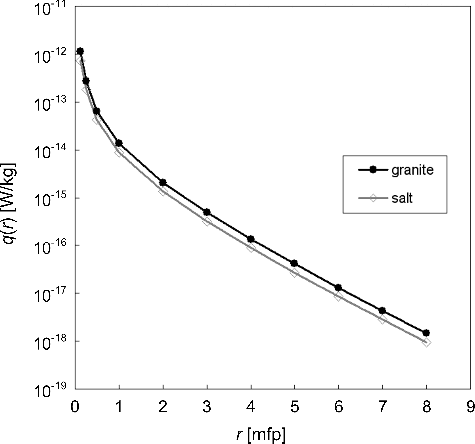
Resulted q(r) curves were approximated by function, where coefficients ai′ and bi′ for a given photon energy (1.25 MeV) and various rocks were determined by the least square technique.
Analysis of the volume integral dependences of energy release in granite and salt on the distance from the point source () showed that 90% of the energy is absorbed within a volume bounded by a sphere centered at the location of source with a radius of 4 mean free path (mfp) of unscattered radiation. Values of photons mfp for granite and salt materials are 0.27 and 0.33 m, respectively.
Figure 4. Volume integral energy release in granite and salt generated by one decay of 60Co in point source.
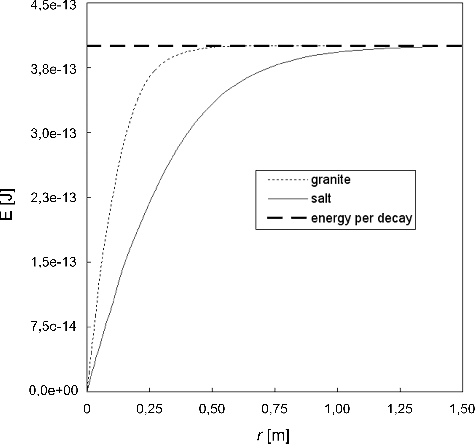
As a result of source surface integration of q(r) dependences, estimates of the spatial distribution of the specific energy release rate Q(z) from a plane infinite source have been obtained in the form , where z is the distance from the source, As is the surface activity of the source (Bq/m2), Qγ is energy release rate per unit activity of a given radionuclide (W/Bq). It was assumed that the activity is distributed uniformly over the surface. The ai and bi constants (1/m) for various absorbing materials and 60Co gamma radiation are: granite – a1 = 6.13, b1 = 14.67, a2 = 6.94, b2 = 84.17; salt – a1 = 4.97, b1 = 12.00, a2 = 5.82, b2 = 67.58.
shows the dependences of Q(z) in granite and salt on the distance from a plane infinite source with a uniform distribution of 60Co over the surface. It was supposed that the source is located in the z = 0 plane.
6. Energy self-absorption in heat-generating elements
To estimate the self-absorption of gamma radiation energy in the heat-generating elements of the device, calculations of energy absorbed in the spherical sources with uniform distribution of radionuclide over volume were made using the Monte Carlo method [Citation24]. The dependence of self-absorption fraction δ, defined as the ratio of the absorbed energy in the source to the total released energy, on the radius of source is shown in . The radius is expressed in terms of the mfp in source material for photons with an energy of 1.25 MeV (1 mfp = 2.1 cm).
Figure 6. The self-absorption fraction of gamma radiation energy in spherical sources of different radii uniformly filled with the 60Co.
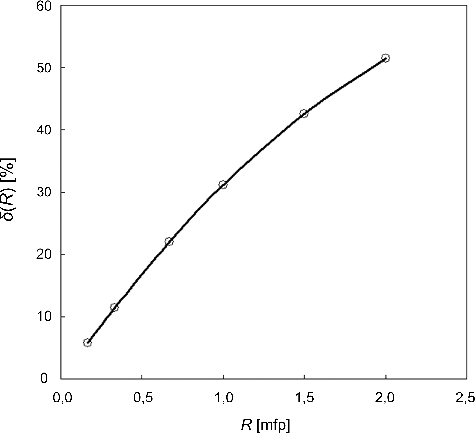
According to the estimates, the heat-generating elements of the device based on direct heating of rocks by radiation with 60Co radionuclide can be made in the form of spheres with a radius of about 1 cm [Citation22]. Let us consider a spherical heat-generating element with a cavity of 0.7 cm radius filled with 60Co and molybdenum shell 0.3 cm thick. According to , the fraction of energy self-absorption in 60Co will be about 10%. About 5% of energy is absorbed in the shell. This value is based on the Monte Carlo estimates [Citation24] and assumption that the absorbed energy fraction in the interval from 0.0 to 0.5 mfp increases linearly and is ∼15% at 0.5 mfp. As a result, δ in the heat-generating element will be about 15%, which can be considered as acceptable value from the point of view of the realization of direct heating by radiation.
It should be noted that for 137Cs radionuclide, the curve δ(R), where R is expressed in terms of the mean free paths of unscattered gamma radiation of 137Cs, practically coincides with the curves for 60Co shown in . Due to the lower specific energy release rate, much more 137Cs is required to achieve the same values of descent velocity that leads to larger size of heat-generating elements. Because of that, self-absorption fraction in the spherical heat-generating elements for the device based on 137Cs is significantly higher than for 60Co device. This circumstance makes it difficult to use of 137Cs as a heat-generating nuclide, since the value of δ is estimated more than 30%.
7. Assessments of parameters of sinking
The approaches given in [Citation25] were used to describe the motion of the device and to determine the temperature fields in the surrounding rocks. It was assumed that the plane device with 60Co radionuclide uniformly distributed over the surface moves downward at a constant velocity. The device is sinking as a result of heating and melting of surrounding material, followed by displacement of melt by the heavier device. It was assumed that the motion is one-dimensional.
The following conditions were used as criteria for the application of the one-dimensional approximation: (1)
(1) where tm – time required to reach the melting point on the boundary of sinking device with rock to be melted, tb – time required to transfer heat to the boundary of sinking device in horizontal direction by thermal conduction, th – time required for sinking to the depth h, where h is the thickness of the sinking device.
One can find tm solving transient thermal conduction equation for infinite slab [Citation26]: (2)
(2) where Tm – melting point of surrounding rock, λ – thermal conductivity of the rock, χ – thermal diffusivity of the rock, q0 – heat flux from unit area of the source.
Time required for thermal conduction to transfer heat to the sinking device boundary in horizontal direction is [Citation25]: (3)
(3) гдеRb – half-size of the sinking device in horizontal direction (for example, radius).
th can be estimated using descent velocity V: (4)
(4)
Assuming that Rb = 1 m, descent velocity V = 1 km/year, heat flux required for sinking at a given velocity q0 = 2·105 W/m2; tm, tb, and th values were obtained: for granite rock – tb = 1.4·106 s, tm = 104 s, th = 7·103 s; for salt rock – tb = 8·105 s, tm = 70 s, th = 1·104 s. Conditions (Equation1(1)
(1) ) are satisfied, that allows to use the one-dimensional approximation in solving the thermophysical problem for determining the descent velocity and the temperature fields in surrounding rocks.
Let us assume that the device containing 60Co is located in z = 0 plane, z < 0 region is the zone of surrounding rock to be melted, z ≥ 0 region is the melt of rock (see ).
To find the device descent velocity V, we use the system of heat conduction equations in the one-dimensional quasi-stationary approximation [Citation25] written in a coordinate system moving with the device: (5)
(5) with the boundary conditions: T1(z)|z =0=T2(z)|z =0 =Tm; T2(z)|z = −∞ = T0;
and with a source of volumetric heat release rate due to absorption of gamma radiation in surrounding rocks:
, −∞ < z < ∞. The following notation is used in the system of EquationEquation (5)
(5)
(5) : Ti(z) is the spatial temperature distribution in the ith zone, Ci, λi is the volumetric heat capacity and the thermal conductivity coefficient of the ith zone, i = 1 corresponds to the zone of the rock to be melted, i = 2 is the zone with melted rock; As is the activity of radionuclide per unit surface of the device; Qγ is the energy release rate per unit activity of this radionuclide; Tm is the melting point of the surrounding rock; T0 is the temperature of the surrounding rock at z → −∞.
The temperature distribution Ti(z), i = 1,2, which is the solution of the system of EquationEquation (5)(5)
(5) , is defined as follows:
(6)
(6) or by introducing the notations:
;
;
;
;
;
;
:
(7)
(7)
The resulted T(z) distributions in granite and salts are shown in the graphical form in .
Figure 8. Temperature distribution in granite and salt corresponding to 60Co average surface activity of 5·1017 Bq/m2.
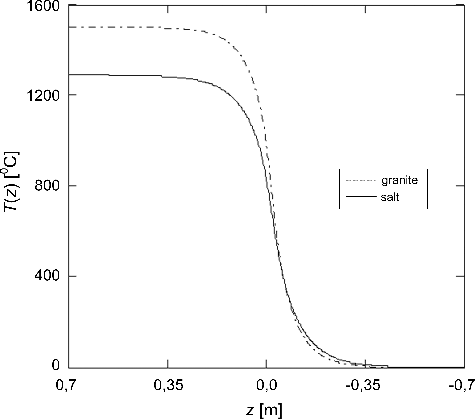
A transcendental equation for determining of the descent velocity V has been derived from the system of EquationEquation (5)(5)
(5) :
(8)
(8) and can be written in dimensionless form as follows:
(9)
(9)
From EquationEquation (9)(9)
(9) , one can derive a simplified expression for descent velocity (exceeding 1 km/year):
(10)
(10) meaning that heat flux
in the direction of sinking is consumed to heat the surrounding rock materials to the melting point.
Dependences of the descent velocity in granite and salt on the average surface activity of 60Co radionuclide in the device in accordance with EquationEquation (8)(8)
(8) are shown in . As can be seen, to achieve descent velocity of about several kilometers per year, the surface activity of 60Co ∼5·1017 Bq/m2 is required. Such value of activity can be achieved in a device with spherical heat-generating elements with a diameter of about 2 cm.
Figure 9. The descent velocity in granite and salt, depending on the average surface activity of the 60Co in a device based on direct heating of rocks by radiation.
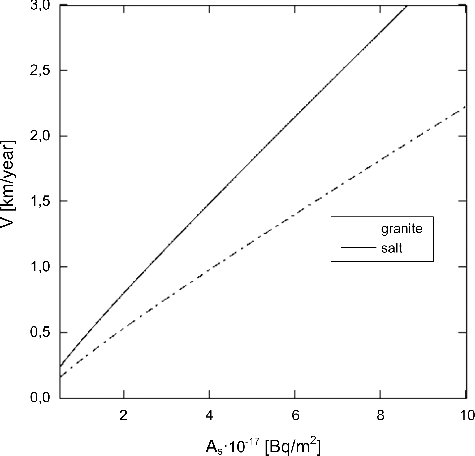
The following constants were used [Citation27–29] to perform estimates given in this section: granite – C1 = 3.12·106 J/(m3·K), C2 = 2.86·106 J/(m3·K), λ1 = 1.6 W/(m·K), λ2 = 2.06 W/(m·K), χ = 7.2·10−7 m2/s, Tm = 950 °C; salt – C1 = 2.49·106 J/(m3·K), C2 = 2.11·106 J/(m3·K), λ1 = 1.5 W/(m·K), λ2 = 2.5 W/(m·K), χ = 1.2·10−6 m2/s, Tm = 801 °C.
8. Conclusion
The energy transfer mechanism of direct heating of rocks by radiation for devices based on RW self-burial method has been considered. The currently known methods of sinking by melting of rocks due to the energy released during radioactive decay imply the heat transfer through thermal conductivity. It leads to high levels of maximum temperatures and temperature gradients in the elements of the device due to absorption of significant part of energy inside the device. When implementing the proposed mechanism, the main part of radiation emitted by the heat-generating radionuclides is absorbed outside the device directly in the rocks to be melted, allowing reducing the temperatures in the device elements.
Based on the defined conditions for realization of direct heating by radiation, 60Co was selected as the most suitable heat-generating radionuclide. Estimates of spatial distribution of energy release rate in surrounding rocks as a result of absorption of radiation from point and infinite plane sources with 60Co radionuclide are made. Approximate expressions are derived for a source of volumetric heat in granite and salt rocks. Using these data, the expressions for determining the descent velocity as a function of average surface activity of radionuclide in the sinking device and analytical expressions for temperature distributions in the surrounding rocks were derived from the system of heat conduction equations in one-dimensional quasi-stationary approximation. Calculations made for granite and salt showed that an average surface 60Co activity of about 1017 Bq/m2 is required to achieve a descent velocity of 1 km per year.
The proposed energy transfer mechanism expands the prospects of using the known scheme of RW self-burial, contributing to the increase of reliability. The mass of RW that can be disposed in this way can reach several tons per campaign, which is equivalent to the annual generation of RW with transuranium elements at 25 NPP units.
Disclosure statement
No potential conflict of interest was reported by the authors.
References
- IAEA Safety Standards Series No. GSG-1. Classification of radioactive waste. General safety guide. Vienna: International Atomic Energy Agency; 2009.
- Geologic Disposal of Radioactive Waste in Perspective. Nuclear energy agency. France: Organization for economic co-operation and development; 2000.
- Donea J. Operation ‘Hot Mole’. Euro-Spectra. 1972;11:102–109.
- Logan SE. Deep self-burial of radioactive wastes by rock-melting capsules. Nucl Technol. 1974;21(2):111–124.
- Byalko AV. Nuclear waste disposal: Geophysical safety. Boca Raton, Florida: CRC Press; 1994.
- Efankin VG, Kashcheev VA, Poluektov PP, et al. Laboratory modelling of self-disposal of radioactive wastes. At Energy. 1994;76(2):161–164.
- Logan SE. Deeper geologic disposal: a new look at self-burial. In: Proceeding of the WM’99 Conference; 1999 Feb 28–Mar 4; Tucson, AZ.
- Gibb FGF. High-temperature, very deep, geological disposal: a safer alternative for high-level radioactive waste ? Waste Manage. 1999;19(3):207–211.
- Kosachevskiy LY, Sui LS. On the ‘self-burial’ of radioactive wastes. J Tech Phys. 1999;69:123–127.
- Stevenson DJ. Mission to Earth's core – a modest proposal. Nature. 2003;423(6937):239–240.
- Ojovan MI, Gibb FGF, Poluektov PP, et al. Probing of the interior layers of the Earth with self-sinking capsules. At Energy. 2005;99:556–562.
- Ojovan M, Gibb FGF. Feasibility of very deep self-disposal for sealed radioactive sources. In: Proceeding of the WM’05 Conference; 2005 Feb 27–Mar 3; Tucson, AZ.
- Ojovan MI, Gibb FGF. Chapter 7, Exploring the Earth's Crust and Mantle Using Self-Descending, Radiation-Heated, Probes and Acoustic Emission Monitoring. In: Lattefer PA, editor. Nuclear waste research: siting, technology and treatment. New York (NY): Nova Science Publishers; 2008. p. 207–220.
- Spasova LM, Gibb FGF, Ojovan MI. Characterisation of partial melting and solidification of granite E93/7 by the acoustic emission technique. Mater Res Soc Symp Proc. 2008;1107:75–82.
- Ojovan MI, Poluektov PP, Kashcheev VA. Super-deep HLW Self-disposal option. In: Proceeding of the WM’11 Conference; 2011 Feb 27–Mar 3; Phoenix, AZ.
- Bertka C, Blackman DK, Ildefonse B, et al. Executive summary: ‘Mantle Frontier’ workshop. Sci Drill. 2011;11:51–55.
- Spasova LM, Ojovan MI, Gibb FGF. Acoustic emission on melting/solidification of natural granite simulating very deep waste disposal. Nucl Eng and Des. 2012;248:329–339.
- Ojovan MI, Poluektov PP, Kascheev VA. The self-disposal option. Nucl Eng Int. 2012;57(696):28–29.
- Chen W, Hao J, Chen Z. A study of self-burial of a radioactive waste container by deep rock melting. Sci Technol Nucl Inst. 2013 [2017 Oct 02]. https://www.hindawi.com/journals/stni/2013/184757
- ; Arutyunyan RV, IBRAE RAN, inventor, assignee. Device for submersion in melting geological rocks. Russian Federation patent RU 2535199 C1. 2014 Dec 10.
- ; Arutyunyan RV, IBRAE RAN, inventor, assignee. Device for submersion in melting geological rocks. Russian Federation patent RU 2577517 C1. 2016 Mar 20.
- ; Arutyunyan RV, Shvedov AM, IBRAE RAN, inventors, assignees. Radioisotope device for sinking in geological formations. Russian Federation patent RU 2601288 C1. 2016 Oct 27.
- ICRP. Publication 107: Nuclear decay data for dosimetric calculations. Ann ICRP. 2008;38(3):120.
- Zhitnik AK, Ivanov NV, Marshalkin VE. The TDMCC Monte Carlo capability for spatial kinetics calculations of reactor cores. Trans Am Nucl Soc. 2004;91:248–249.
- Arutyunyan RV, Bolshov LA, Borovoy AA, et al. Ядерное топливо в объекте «Укрытие» чернобыльской АЭС [Nuclear fuel in the ‘Shelter’ facility of the Chernobyl nuclear power plant]. Moscow: Nauka; 2010. Russian.
- Rohsenow WM, Hartnett JP, Cho YI, editors. Handbook of heat transfer. 3rd ed. New York (NY): McGraw-Hill Professional; 1998.
- Bayuk EI, Tomashevskaya IS, Dobrynin VM. Физические свойства минералов и горных пород при высоких термодинамических параметрах [Physical properties of minerals and rocks at high thermodynamic parameters]. Moscow: Nedra; 1988. Russian.
- Vosteen H, Schellschmidt R. Influence of temperature on thermal conductivity, thermal capacity thermal diffusivity for different types of rock. Phys Chem Earth. 2003;28:499–509.
- Eppelbaum L, Kutasov I, Pilchin A. Applied geothermics. New York: Springer; 2014.

